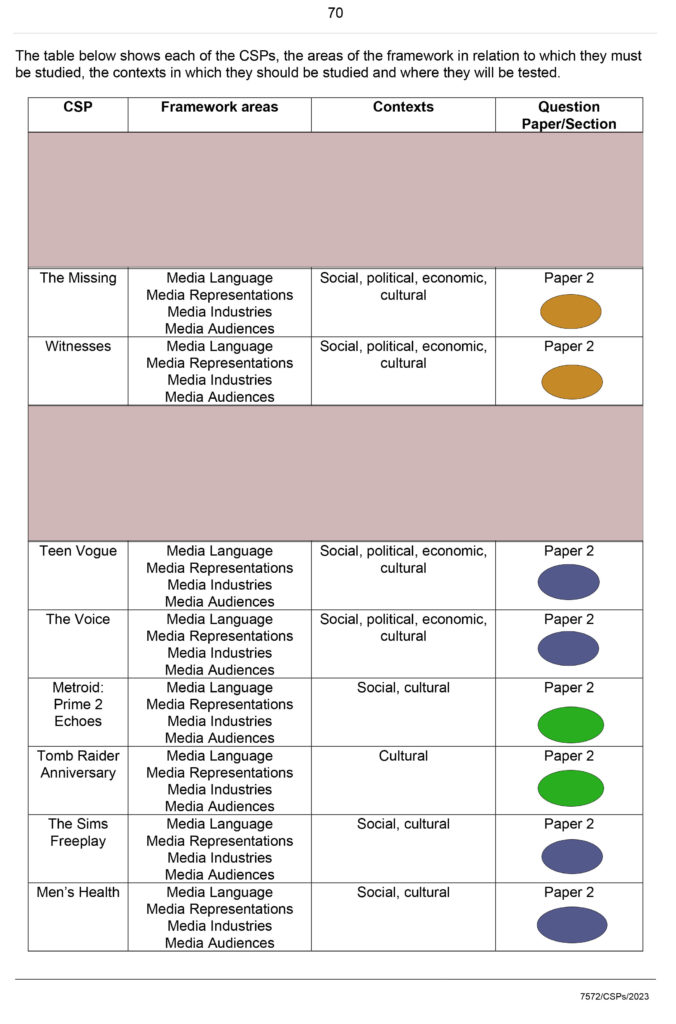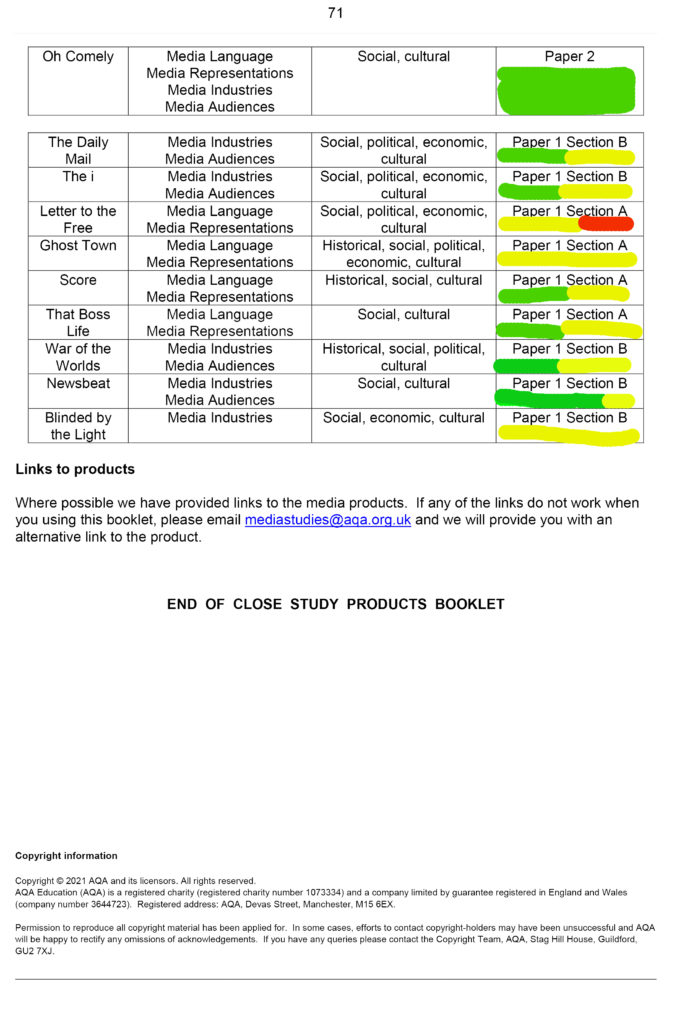describe – give a detailed account in words of.
command – give an order.
compare – note the similarity or dissimilarity between things
evaluate – form an idea of the amount, number, or value of; assess.
analyse – in-depth look at something with an aim to get an accurate explanation
knowledge – awareness or familiarity gained by experience of a fact or situation.
understanding – an individual’s perception or judgement of a situation.
| What do you know about | What meaning or understanding do you have of their ideas? Put another way – how can you apply their ideas to your CSP’s? | |
| Noam Chomsky | Five filters of Media – (1) ownership; (2) advertising; (3) official sources; (4) flak; and (5) marginalizing dissent. | Chomsky can be used in terms of media ownership, audience effects, textual analysis and representation. Essentially, he argued that the mass media is used by the elite in society to ‘manufacture consent’ towards the dominant ideology. So for example, it is possible to see this in terms of the Daily Mail (with it’s pro-establishment views on money, the monarchy, the military, patriarchy etc media ownership) It is also possible (to some extent) to see this in terms of Tomb Raider, Score (prioritising patriarchal values, role of advertising) Challenges to the process of ‘consent’ (ie alternative views to society can be found in Blinded by the Light, Letter to the Free, Ghost Town (dispelling the myth of the common enemy?) |
| James Curran | Curran writes about the Liberal Free Press Is connected to the ideas of Habermas Writes specifically about diversity in terms of ownership, participation, representation, consumption | Film CSP – blinded by the light – diversity in terms of ownership, participation, representation, consumption |
| John Seaton | ||
| Jurgen Habermas | Habermas wrote about the Transformation of the public sphere in 1962 With the introduction of the printing press, reading and writing transformed the way in which ideas and decisions were made. The public sphere is where public decisions are made (ie courts, parliament) The private sphere is where private decisions are made (family, friends etc) Habermas thought that new forms of media enabled ordinary citizens to be more actively engaged in society. which formed a new phenomenon called public opinion. Spearheading this shift was the growth of a literary public sphere | Habermas was active in trying to create an inclusive society. Many aspects of media are also attempting to create a more inclusive society, i.e. social media tries to connect people through the private sphere (friends and family). Media is really important for helping individuals to connect to society and be part of the decision making process. It is an example of how democracy works. It stops authoritarian regimes or (hopefully) inequality It promotes participation and emancipation. |
| Lasswell | Lasswell’s model of communication describes an act of communication by defining who said it, what was said, in what channel it was said, to whom it was said, and with what effect it was said. | |
| Lazarfeld | The two-step flow of communication model says that most people form their opinions under the influence of opinion leaders (influencers), who in turn are influenced by the mass media. | Suggestion is that audiences are active, as they actively seek out the information. However, you could also argue that they’re passive, as they are not really forming their own opinions, simply following the trends created by big influencers. |
| Uses and Gratifications | The Uses and Gratifications Theory is a Mass Communication theory that focuses on the needs, motives and gratifications of media users. The theory states that media consumers are passive consumers of mass communications; rather, they play an active role in media consumption. | 1. diversion (escapism) media usage may make up for a lack of satisfaction in personal life 2. personal statements soap characters may be seen as companions in the absence of family and friends. 3. Personal identity people may use characters they associate with in order to help the make tough life decisions. 4. Surveillance People use the media to obtain information about the world. |
| Stuart Hall | Argues that there are a number of messages that are encoded in media by producers and then decoded by audiences. | For instance, it is a common horror movie trope for the characters who have sex to end up dying. Message = anti-sex. |
| George Gerbner | Reception theory: suggests that exposure to reinforced messages will influence our ideas and attitudes. Cultivation theory: high frequency consumers of media texts are more susceptible to media messages and the belief that they are real and valid. People who consume large amounts of violent media texts are affected by the Mean World Syndrome (the belief that the world is a far worse and dangerous place than it actually is). | |
| David Gauntlett | Disagrees with Gerbner, suggests that audiences use a pick n mix approach, where we actively choose what we view. Gerbner believes we are passive and are fed information. |
WHO
Hearst communication (CEO – Steven R. Swartz) > men’s health
SAYS WHAT
see media post
CHANNEL
print through lifestyle magazine
TO WHOM
see media post
WITH WHAT EFFECT
89,000 average buys per issue
(66,000 paid subscriptions)
Two step flow of communication
Vin Diesel is an opinion leader, who people actively follow. People will be more likely to buy certain products etc. if they know that an opinion leader such as Vin Diesel supports it.
Uses and Gratifications
Self-esteem – page 13 is aimed at improving readers self-esteem through getting back in shape and improving fashion style.












